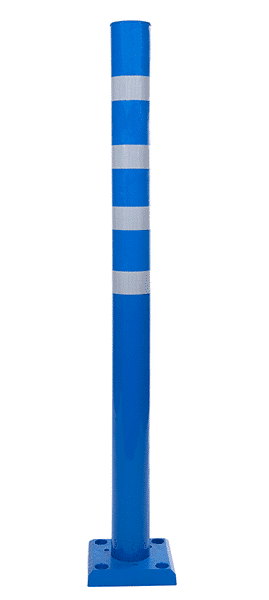
When planning and designing public spaces, providing equal access to all is now a key aim—and this is where the Universal Design (UD) concept is helpful. However, with such a wide variety of people with various levels of ability, unfortunately at times certain groups can slip through the cracks and not have their needs adequately addressed, which can lead to unnecessary barriers to access.
For people with low vision, navigating many aspects of the built environment is challenging. Recently, one area that has been identified as a particular concern is the colour and height of the required safety bollard in the built environment including for disabled car parks.
When it comes to accessible car park bollards, many include some small but significant design flaws that make it difficult for those with a vision impairment to safely access. But the good news is, they can be easily rectified. Read on to find out more.
Order Blue Accessible Car Park Bollards Here
What are the requirements and regulations for disabled car park bollards?
As the AS 2890.6 states, a bollard is required for all accessible car parking spaces—however, there is no clear instruction on the specific design requirements. This means there have been countless incidents where people have reversed into unsuitable bollards, which has led to many calls to our office seeking clarification on whether the bollards are in fact non-compliant. Sadly, due to a lack of design specifications within the standard, the answer is often a disappointing no.

2.4.5.3 Barriers
Barriers shall be constructed to prevent vehicles from running over the edge of a raised platform or deck of a multi-storey car park including the perimeter of all decks above ground level. They are required wherever the drop from the edge of the deck to a lower level exceeds 600 mm. At drops between 150 mm and 600 mm, wheel stops (see Clause 2.4.5.4.) shall be provided. Barriers shall comply with the following requirements:
(a) They shall be designed structurally for the loading requirements of AS/NZS 1170.1.
(b) If at the end of the parking space, they shall be at least 1.3m high so that the drivers of cars backing into the space can see the barrier above the rear of the car.
NOTE: The upper portion of such a barrier may be a light structure provided for sighting purposes only.
(c) They shall not be made from brickwork, unreinforced concrete or other materials likely to shatter on impact.
As you can see, the standard unfortunately lacks clarification around the design of the bollards, in particular the height and colour, which has created an issue for those with low vision.
When it comes to barriers in car parks, the AS/NZS 2890.1:2004 (Incorporating Amendment No. 1) Parking facilities Part 1: Off-street car parking standard states:
Best practice for accessible car park bollard height
Back in 2012, in response to section (b) shown above, we immediately adopted a best practice position to ensure the minimum height of bollards we recommended was 1300 mm. Since then, all bollard manufacturers across Australia have started manufacturing accessible car park bollards with a minimum height of 1300 mm. This has gone a long way in addressing the issue of reversing into bollards that are difficult to see.
Best practice for accessible car park bollard colour
When talking to those with a vision impairment about accessible car park bollards, another issue was identified regarding the colour. Most of the bollards manufactured now are coloured ‘Safety Yellow’, which at first may seem like a sensible idea as it stands out. The trouble is, when the bollard is situated within a car park that features the Safety Yellow diagonal striping, instead of standing out, the bollard blends in, creating a hazard for anyone with low vision. To address this, we now recommend that all accessible car park bollards are coloured blue, which contrasts well with the yellow and is much easier to see.
Final word on disabled car park bollards
As described above, to achieve a truly Universal Design, there are many factors that need to be considered—and sometimes a small tweak in colour or height makes all the difference.
If you have a question on bollards, or any other safety or access products, contact our team on +61 3 9001 5805 or 1300 994 890. We’re always happy to help!